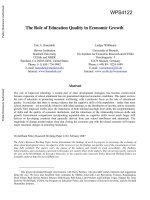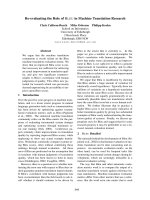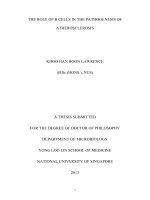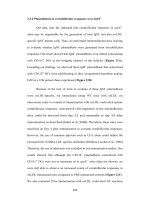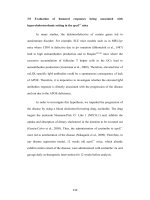The role of cultural fit in translation
Bạn đang xem bản rút gọn của tài liệu. Xem và tải ngay bản đầy đủ của tài liệu tại đây (58.74 KB, 2 trang )
The role of cultural fit in translation:
Cultural relevance is an important part of translation because it ensures that the
reader can fully grasp the meaning of the text. At the same time, it is also an agent
that helps maintain the cultural context and prevent any cultural disagreement.
When translating, you need to always be mindful of the different cultures of your
readers and anticipate their reactions to your translation. Once you understand
these factors, you can create accurate and culturally appropriate translations.
A text may contain culturally specific or sensitive elements, and when translating.
Misunderstandings can happen when there is no understanding of both cultures
it is necessary to understand the differences between the culture of the source
language and the culture of the target language.
How to create cultural fit in translation?
Here are some steps to create cultural fit in translations:
Thoroughly research the culture as well as the core values of the target audience.
This helps you understand how they react to a certain word or phrase.
Be careful when choosing words. Always be aware of the implications your
sentences can convey in both the source and target languages.
Explain or add background information to ensure readers can fully grasp the context
of the text.
Common mistakes when translating culturally sensitive texts:
"Put your feet up" might be an appropriate tagline for a Western audience. However,
in the UAE and many parts of Asia, it is considered rude to show the soles of the
feet. So it needs a localized translation of this campaign, find an alternative phrase
with the same meaning
- translate without careful study. To create an accurate and appropriate
translation, the translator needs to thoroughly understand the culture as well
as the core values of the readers.
- Another mistake is translating too close to the original without considering the
meaning of the words. This can change the meaning of the text and mislead
the reader.
Trong sách Phúc âm Mark của kinh Tân Ước, cụm từ “children of the bridechamber”
(những đứa trẻ của phịng tân hơn) sẽ rất lạ lẫm đối với những người không quen
thuộc những biểu hiện hay dùng của người Do Thái. Biểu hiện này dịch ra tiếng Anh
là “the friends of the bridegroom” hoặc “wedding guests”, nghĩa là “bạn bè của chú
rể” hoặc “khách dự đám cưới”.
Pepsi's advertising slogan is: "Come alive with Pepsi!" (live with Pepsi) in the
German market “come alive” translates directly into German as “come out of the
grave”.
The same slogan in Asian countries has also been translated directly to "bring your
back ancestors from the dead".
Note:
Readers of the target language will not be able to fully grasp the meaning of the
source language if translated literally. In cases like these, you'll need to choose a
more flexible and loose translation to ensure the meaning.
You also need to pay special attention to the implications of word usage in both the
source and target languages. Certain words can have negative or positive
connotations. This can completely change the text meaning.
Cultural ties can also be lost in the translation process. Therefore, sometimes you
need to footnote the explanation or the side information to ensure that the reader can
fully grasp the context of the text.

